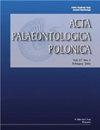在智利北部深海海底发现的一种新的小型齿鲨化石,并对喙鲸的体型演化和古生物地理作了一些评述
IF 1.9
3区 地球科学
Q2 PALEONTOLOGY
引用次数: 0
摘要
. 2023. 在智利北部深海海底发现的一种新的小型齿鲨化石,并对喙鲸的体型演化和古生物地理作了一些评述。古生物学报,68 (X): xxx-xxx。由于主要来自深海海底的重要化石记录,喙鲸(齿鲸科)的进化史已经广为人知。本文描述了在智利北部Pisagua港附近的上新世-更新世深海沉积物(约1000米)捕鱼活动中发现的一种ziphiids的部分头盖骨,并将其称为新物种Ihlengesi changgoensis。Ihlengesi changoensis不同类型物种Ihlengesi saldanhae,南非从海底,通过更细长的前颌骨的囊窝因此更在前面位于前颌骨的孔;每个前颌嵴的背缘明显腹侧倾斜,并在前视图中产生顶点的急性背侧轮廓;右鼻形成部分的前外侧延伸较少;鼻的侧缘不向前发散但弱凸;鼻额线前尖。系统发育支持I. changgoensis和I. saldanhae之间的姐妹分类群关系,两者都是冠齿蛾Hyperoodontinae的成员。Ihlengesi changgoensis与I. saldanhae和其他ziphiids化石共享一个小的身体尺寸(估计长度为3.5米),这支持了过去小喙鲸(小于4米)比今天更常见的假设。最近拉链类动物向更大体型的转变可能是饮食从鱼类逐渐转变为头足类动物,以及与海豚竞争的结果本文章由计算机程序翻译,如有差异,请以英文原文为准。
A new diminutive fossil ziphiid from the deep-sea floor off northern Chile and some remarks on the body size evolution and palaeobiogeography of the beaked whales
. 2023. A new diminutive fossil ziphiid from the deep-sea floor off northern Chile and some remarks on the body size evolution and palaeobiogeography of the beaked whales. Acta Palaeontologica Polonica 68 (X): xxx–xxx. The evolutionary history of the beaked whales (Ziphiidae), odontocetes nowadays adapted to deep diving, is well known thanks to a significant fossil record mainly from the deep ocean floors. A partial cranium of a ziphiid recovered from Plio-Pleistocene deep sea deposits (about 1000 m) off the port of Pisagua, northern Chile, during fishing activity is here described and referred to the new species Ihlengesi changoensis . Ihlengesi changoensis differs from the type species Ihlengesi saldanhae , from the sea floor off South Africa, by having a more elongated premaxillary sac fossa and consequently a more anteriorly located premaxillary foramen; dorsal margin of each premaxillary crest sloping markedly ventrolaterally and generating an acute dorsal profile of the vertex in anterior view; less anterolateral extension of the right nasal forming part of the premaxillary crest; lateral margins of the nasals not anteriorly diverging but weakly convex; nasofrontal suture anteriorly pointed. The phylogeny supports a sister-taxon relationship between I. changoensis and I. saldanhae, both members of the crown ziphiids Hyperoodontinae. Ihlengesi changoensis shares with I. saldanhae and other fossil ziphiids a small body size (estimated length 3.5 m) supporting the hypothesis that in the past small beaked whales (<4 m) were more common than today. Such recent shift of the ziphiids towards a larger size could be the result of a progressive change of diet from fish to cephalopods, to the competition with the delphinids
求助全文
通过发布文献求助,成功后即可免费获取论文全文。
去求助
来源期刊

Acta Palaeontologica Polonica
地学-古生物学
CiteScore
2.80
自引率
5.60%
发文量
36
审稿时长
12.5 months
期刊介绍:
Acta Palaeontologica Polonica is an international quarterly journal publishing papers of general interest from all areas of paleontology. Since its founding by Roman Kozłowski in 1956, various currents of modern paleontology have been represented in the contents of the journal, especially those rooted in biologically oriented paleontology, an area he helped establish.
In-depth studies of all kinds of fossils, of the mode of life of ancient organisms and structure of their skeletons are welcome, as those offering stratigraphically ordered evidence of evolution. Work on vertebrates and applications of fossil evidence to developmental studies, both ontogeny and astogeny of clonal organisms, have a long tradition in our journal. Evolution of the biosphere and its ecosystems, as inferred from geochemical evidence, has also been the focus of studies published in the journal.
 求助内容:
求助内容: 应助结果提醒方式:
应助结果提醒方式:


